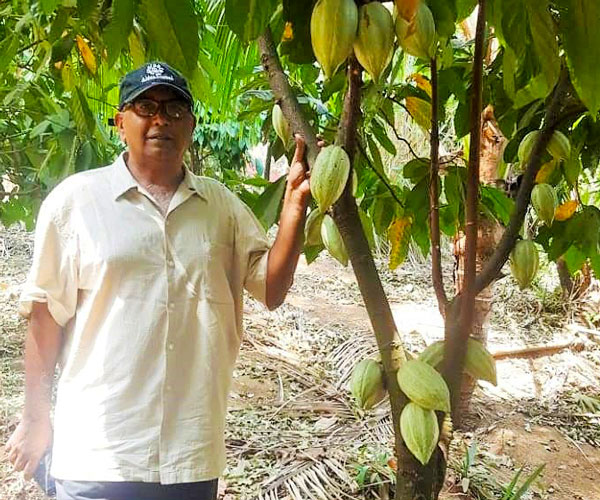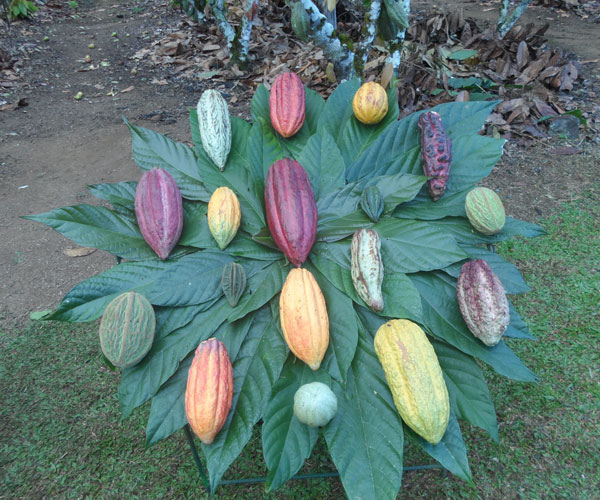
Cocoa from Central America is renowned for its high quality and fine aroma. Productivity is low in the region – it contributes with less than 1% to the global production – but its cocoa beans end up in the finest chocolate in the world.
Cocoa cultivation across Guatemala, El Salvador, Honduras, Nicaragua and Costa Rica is traditionally in the hands of smallholders, who own as little as two or three hectares. But in recent times international companies, consortia and private investors have acquired bigger parcels, up to 500 hectares, introducing highly technical cocoa production systems that may challenge the smallholder’s traditional place in the cocoa productive cycle. In addition, rising temperatures and erratic rainfall due to climate change are posing further threats to cocoa fields. What will then be the future of millions of small farmers in Central America, and worldwide?
"It's time to create a new strategy that combines knowledge development and cross-learning," said Falguni Guharay, programme manager with Climate Smart Cocoa Central America and Caribbean, a programme launched by the World Cocoa Foundation (WCF), based in Managua, Nicaragua, and funded by the United States Agency for International Development (USAID). "Ideally, to scale Climate Smart Cocoa, the private sector should increase investments and engagement. On the other side, cocoa farmers should adopt smart-agriculture practices that make their fields more resilient towards climate change with improved cocoa productivity."
Guharay is a newly elected TWAS Fellow and the first-ever from Nicaragua. After earning a PhD in zoology in 1982 from the University of Nottingham in the UK, he served as a professor and research director from 1985 to 1990 in the school of plant protection at the National Agricultural University in Nicaragua.
From 1991 to 2004, he joined Tropical Agronomic Center for Research and Education in Turrialba, Costa Rica, where he first worked as an associate professor and then as a regional programme leader. Since 2016, Guharay is working in wide-ranging projects under WCF, acting as a driving force to protect the future of cocoa – and cocoa farmers – in Central America.
"I've been living in Nicaragua since 1984, but I'm a native of India, and my election to TWAS has been warmly supported by two Indian colleagues who are TWAS Fellows themselves," he explained in a recent interview. "As I am currently the only TWAS Fellow in Nicaragua, it is on me to make the best of this prestigious affiliation and reach out to scientists, private bodies and farmers through meetings, newsletters and personal contacts."
Sweet crop, bitter truth
Cocoa (Theobroma cacao) is native to the Amazon Basin but its domestication took place in Central America – in the so-called Mesoamerican Biological Corridor – a small area if compared to bigger fields in West Africa. With time, however, Central America has turned into a valuable source of the highest-grade cocoa.
Still there are problems. In the last 30 years, in Central America cocoa has been promoted as a robust crop, able to survive a wide range of soil and climate conditions. For this reason, it has been planted everywhere, without precise knowledge of the soil and productivity of the plant type. But cocoa has a low capacity to adapt to adverse conditions, as it requires good organic soil and a lot of water. Some cocoa varieties should be able to self-pollinate – they have both male and female components – but due to genetic limitations, the male and female cells can fail to fuse and produce a fruit.
Early agroforestry cocoa systems were respectful of biodiversity. Cocoa plants grew in the shade of the rainforest canopy surrounded by naturally growing trees such as banana, Inga (a fruit that was part of the indigenous diet) and others. Recently, this old-fashioned system has been overtaken by more aggressive agricultural practices, such as cultivation in full sun, that involve massive loss of tree cover.
But economics is driving the changing practices, which puts both the land and small farmers in danger.
"Planting seeds that could be incompatible from a genetic point of view has generated trees with little productivity, in the range of 350 kg/ha. This is a very modest yield for smallholders, which makes a farmer's total net income of USD480 per hectare, well below the survival standards," observed Guharay. "On the contrary, companies' open-sun fields produce an average of 2-3 tons per hectare."
To reverse the trend, Guharay participated in launch of two national cocoa programmes in Nicaragua, in 1998 and 2006, aimed at helping small producers to overcome stagnation. But the main mistake, as he admitted, was urging farmers only to improve their production and diversify their crops. The focus on developing their business abilities and capacity to work in tandem with cocoa companies was not a priority and only came around much later. "In addition," he explained, "we did not consider that cocoa prices are not steady, and yearly fluctuations could put farmers down on their knees. And we ignored ... that changes in climate trends were having increasing impact."
After that, Guharay and his colleagues changed their approach while implementing the Climate Smart Cocoa programme by World Cocoa Foundation and its partners. "After collection of a huge amount of data," he said, "we elaborated climate exposure maps of Central America, projecting what the impact gradient of climate change would be on cocoa fields, in the years ahead."
These climate modelling maps will predict which area is likely to have more development opportunities, serving as a powerful indication of the measures to adopt to protect and increase cocoa plantations' health.
"Climate Smart Cocoa"
This new trend is named Climate Smart Cocoa, an initiative launched in 2016 by WCF aimed at increasing cocoa productivity, enhancing adaptive capacity and reducing greenhouse gas emissions. In addition, it also hopes to increase private sector engagement in long-term sustainability initiatives, in coordination with the public sector and farmers. To this purpose, WCF is partnering with nine member companies and USAID.
A key objective is educating farmers on some aspects of cocoa genetics and cocoa management, empowering them to use innovative agroforestry models to preserve ecosystems' resilience. These actions should increase household incomes, making cocoa's communities stronger and more competitive.
"A huge work we are doing now involves farmers' education: we need to change their mentality," Guharay said. "We explain that there is easy access to information on climate change, with maps and data that can predict plausible situations on their future local plantations. We urge them to take local field data to implement practices based on the predictions. It is both a training and a future investment, because they are scared by novelty and by the idea that they should apply different methods."
Improvement in cocoa farming is possible through integrated efforts of private-public investors, international donors and local farmers. "People need to understand that innovation is not simply a technological process but a social process where ... all actors must work for a common good," Guharay maintained.
"I am a one-person team," he added. "I do research, I bring stakeholders together on national and local level, I assist in preparing business plans working with more than 40 partner organizations. This is my strength: anything I propose to do, is actually done with a network of partners. And my recent election to TWAS will certainly help implement this strategy."
Cristina Serra

